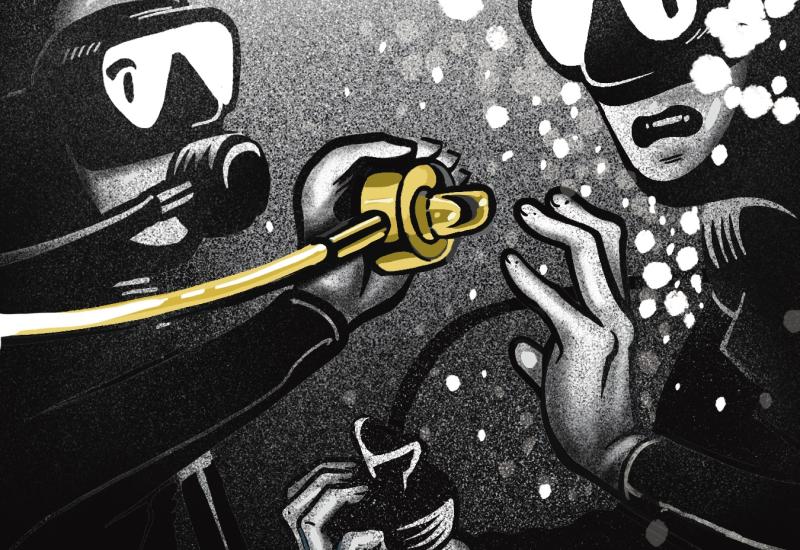A Diver Disappears

Lessons For Life: A Diver Disappears
Shutterstock
June 2001
Setting the Stage
Wayne, his wife Sara and their two daughters had been scuba diving for years with guides at tropical resorts. During these regular excursions, Wayne and Sara had received a beginning certification from a European certification agency. While in college, the daughters earned their open-water C-cards from a U.S. training agency.
Wayne and Sara decided to earn C-cards from a U.S.-based agency, so they performed the necessary classroom and pool work near home and received referral forms for their open-water training dives. The plan was for all four of them to go to their favorite tropical resort. Wayne and Sara would complete their training dives, and then they would all dive together.
During the training dives at the resort, Wayne and Sara both did well, although Wayne, who was overweight, did not exercise regularly and was a chain smoker, used more air than the others. He and his wife had minor problems with the final compass course, but they both performed satisfactorily and completed their open-water certifications. Their instructor, James, suggested they do a fun tour the next day with the whole family, along with Hans, another referral student, who had just completed his open-water dives. The dive plan was for Wayne and Sara to first do a practice compass course. Then they and the other divers would continue along the shallow coral reef and take a look at the wall drop-off.
The Dive
The water conditions were excellent--clear, calm and warm. Upon entering the water, Sara and one of her daughters took a bearing, approximately on a diagonal toward shore, while Wayne and Hans took a bearing approximately parallel to shore. The plan was to do 20 kicks out and then reverse course 180 degrees and do 20 kicks back. James, the instructor, and the other daughter would wait at the starting point.
Sara and her buddy returned easily to their starting point. Hans returned alone and made some unclear hand signals to the instructor. James had the others wait on the bottom while he did a quick check on the course line that Wayne and Hans had used, and then checked with the other dive groups that were also in the water near the boat. Not finding Wayne, James got his group out of the water. On deck, Hans explained that he and Wayne had done the outbound compass course and when it came time to return, Wayne fiddled with his compass and waved Hans off.
The search for Wayne was expanded, both under water and on the surface. With calm seas, clear water and good surface visibility, finding a diver should not have been difficult. The search included professional divers, small boats, aircraft and vehicles checking the shoreline. The wall drop-off was 375 feet from the dive boat, significantly farther than any diver could go on a 20-kick compass course. In fact, the wall was more than four times farther than the distance a diver could cover in 20 kicks.
If Wayne had suffered a medical emergency, an environmental problem, an equipment difficulty, gotten lost or disoriented, he should have been found on the bottom or on the surface, within the vicinity of the boat--but he wasn't.
Legal Actions
Sara brought legal actions against multiple possible defendants, on one hand claiming that she and Wayne were still students in the open-water course, and on the other hand claiming they were on a supervised dive.
Through various legal rulings, all but one defendant was dropped from the case. At trial, the judge ruled that the remaining defendant did not violate any standard, did not cause the accident and provided the wherewithal to execute a reasonable search, therefore, finding for the defendant and leaving Wayne's disappearance a mystery.
Lessons for Life
-
Be fit for diving. Added to smoking's long-term health risks are growing concerns that smoking increases the risks of lung overpressure, decompression sickness, respiratory distress and inefficient breathing.
-
When you buddy dive, clearly communicate any dive plan changes and get agreement before moving on. Also keep in mind that a buddy can help keep things under control and at the very least get help when it is needed.
-
Divers are first responsible for themselves. Dive operators and dive professionals can only facilitate diving; they can't guarantee safety.

ShutterstockLessons For Life: A Diver Disappears
June 2001
Setting the Stage
Wayne, his wife Sara and their two daughters had been scuba diving for years with guides at tropical resorts. During these regular excursions, Wayne and Sara had received a beginning certification from a European certification agency. While in college, the daughters earned their open-water C-cards from a U.S. training agency.
Wayne and Sara decided to earn C-cards from a U.S.-based agency, so they performed the necessary classroom and pool work near home and received referral forms for their open-water training dives. The plan was for all four of them to go to their favorite tropical resort. Wayne and Sara would complete their training dives, and then they would all dive together.
During the training dives at the resort, Wayne and Sara both did well, although Wayne, who was overweight, did not exercise regularly and was a chain smoker, used more air than the others. He and his wife had minor problems with the final compass course, but they both performed satisfactorily and completed their open-water certifications. Their instructor, James, suggested they do a fun tour the next day with the whole family, along with Hans, another referral student, who had just completed his open-water dives. The dive plan was for Wayne and Sara to first do a practice compass course. Then they and the other divers would continue along the shallow coral reef and take a look at the wall drop-off.
The Dive
The water conditions were excellent--clear, calm and warm. Upon entering the water, Sara and one of her daughters took a bearing, approximately on a diagonal toward shore, while Wayne and Hans took a bearing approximately parallel to shore. The plan was to do 20 kicks out and then reverse course 180 degrees and do 20 kicks back. James, the instructor, and the other daughter would wait at the starting point.
Sara and her buddy returned easily to their starting point. Hans returned alone and made some unclear hand signals to the instructor. James had the others wait on the bottom while he did a quick check on the course line that Wayne and Hans had used, and then checked with the other dive groups that were also in the water near the boat. Not finding Wayne, James got his group out of the water. On deck, Hans explained that he and Wayne had done the outbound compass course and when it came time to return, Wayne fiddled with his compass and waved Hans off.
The search for Wayne was expanded, both under water and on the surface. With calm seas, clear water and good surface visibility, finding a diver should not have been difficult. The search included professional divers, small boats, aircraft and vehicles checking the shoreline. The wall drop-off was 375 feet from the dive boat, significantly farther than any diver could go on a 20-kick compass course. In fact, the wall was more than four times farther than the distance a diver could cover in 20 kicks.
If Wayne had suffered a medical emergency, an environmental problem, an equipment difficulty, gotten lost or disoriented, he should have been found on the bottom or on the surface, within the vicinity of the boat--but he wasn't.
Legal Actions
Sara brought legal actions against multiple possible defendants, on one hand claiming that she and Wayne were still students in the open-water course, and on the other hand claiming they were on a supervised dive.
Through various legal rulings, all but one defendant was dropped from the case. At trial, the judge ruled that the remaining defendant did not violate any standard, did not cause the accident and provided the wherewithal to execute a reasonable search, therefore, finding for the defendant and leaving Wayne's disappearance a mystery.
Lessons for Life
Be fit for diving. Added to smoking's long-term health risks are growing concerns that smoking increases the risks of lung overpressure, decompression sickness, respiratory distress and inefficient breathing.
When you buddy dive, clearly communicate any dive plan changes and get agreement before moving on. Also keep in mind that a buddy can help keep things under control and at the very least get help when it is needed.
Divers are first responsible for themselves. Dive operators and dive professionals can only facilitate diving; they can't guarantee safety.










